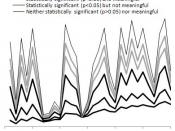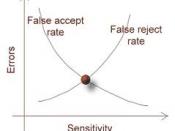In the research, there was the need to base decisions on the behavior of the sample. Any discrepancy in the sample data would lead to inaccurate inference. Which made the selection of appropriate user groups and sample size crucial for the success of the research? Steve mentioned that the senior citizens resisted biometric system during the pilot implementation. They form 27 percent of the VB & FF customers and hence it was necessary to gauge this reaction. Adults and middle aged citizens form 18 and 45% of the VB and FF customer respectively. Together they constitute 63% of the total customers and their opinion is crucial for the implementation of this system. Anne had mentioned that young adults are tech savvy and hence do not resist new technological products. This is not necessary to select the user group of young adults below 25 years. The optimum sample size for the user groups is 90.
This also was the correct hypothesis. Edith had said that the company should only proceed if 65 percent of the personal banking customers favored the biometric system. By relating the hypothesis we were able to determine if sample proportion was equal to or greater than 65%.
Rejecting the null hypothesis when it is true is known as a Type I error. Failing to reject the null when it is false is known as Type II error. The level of significance, alpha denotes the probability of a Type I error occurring. Since the level of significance is specified before completing the test. The risk of a Type I error occurring can be controlled by the person doing the research. The probability of Type I error can be reduced by increasing the probability of making Type II error and vice versa. My decision was made to...


